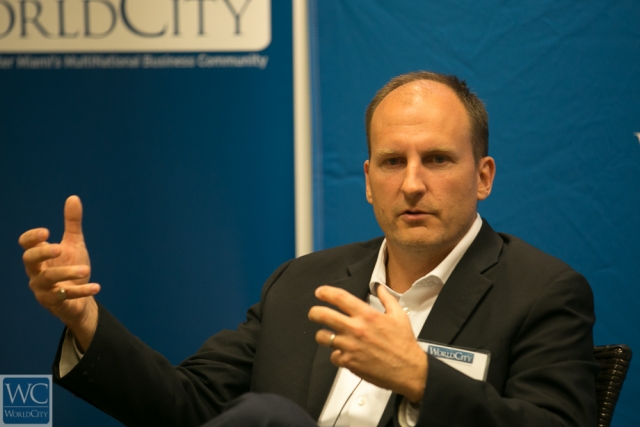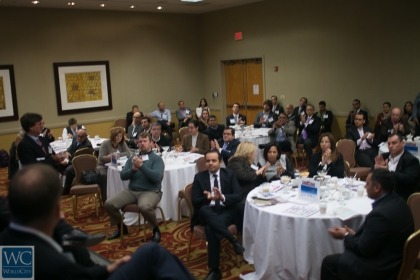South Florida trade dips in 2014; opportunities ahead

South Florida’s trade with the world dipped in 2014, but commerce is poised to gain from growth in Mexico, Central America and the Caribbean and from expansion of the Panama Canal.
Last year, South Florida came in 12th for international trade among the nation’s top 15 customs districts. Area seaports and airports handled $115.93 billion in goods traded directly with foreign countries, down 3.89 percent from 2013.
WorldCity released the data at its Trade Connections event Feb. 20 featuring panelists John Price, managing director of Americas Market Intelligence, and Carlos Cubias, who heads the U.S.-Mexico Trade Lane Center of Excellence for delivery giant UPS.
The decline in South Florida trade – for a second straight year – had been expected, said WorldCity President Ken Roberts. Trade values dipped largely because of a drop in the price of gold and other commodities and because of a decision by computer chip maker Intel to move a factory from Costa Rica to Malaysia. Values had spiked from a surge in the price of gold, shipped in and out of Miami.

John Price, managing director of Americas Market Intelligence, and Carlos Cubias, who heads the U.S.-Mexico Trade Lane Center of Excellence for delivery giant UPS.
By country, Brazil remained the region’s top trade partner in 2014. By product, the area’s leading export category was civilian aircraft, engines and parts. And the top import was gold, although its value slipped by 17 percent last year, Roberts said.
This year, South Florida likely won’t see big changes in trade and could face another dip, said Price.
Weak prices for metals and oil mean lower income for exporting nations in Latin America including Colombia, Chile and Venezuela. And that means lower demand for high-tech goods and luxury goods shipped from South Florida to the Latin American region.
“Going back to December, we have seen a real slowdown, so that is going to mean a tougher quarter for anyone shipping high-value goods,” Price told an audience active in the import-export business.
To adjust, UPS is targeting the fastest-growing markets in Latin America, especially Mexico. The Mexican government is launching reforms to open markets in telecom and other industries. The delivery company recently started door-to-door U.S.-to-Mexico delivery service, Cubias said.
“We have a very strong fleet [in Mexico] and so, we have all the networks,” said Cubias. “It is very significant, as the retail sector is about to boom in Mexico.
Transforming imports to finished goods
Of course, hefty trade volumes also bring challenges.
Economic development often means streets clogged with cars, trucks and delivery vans, said Luigi Boria, mayor of the city of Doral located west of the Miami International Airport.
To ease congestion, UPS has been rolling out Orion, a navigation system designed to give drivers the most efficient routes. That system also may reduce the time a truck is on the street, Cubias said.
Participants asked about the potential impact of an expanded Panama Canal that will let larger ships from Asia cross to the Atlantic and South Florida. The expanded Canal is due to be finished in 2016.
South Florida can gain far more than bigger ships unloading extra containers, Cubias said. He sees warehouses being set up in South Florida as well as factories to transform imports into finished goods.
“There is a lot that can be done with final assembly,” said Cubias, “and being able to redistribute to a very consumer hungry Latin America.”
How will the Obama administration’s rapprochement with Cuba affect South Florida trade?, asked Mimi Whitefield, a Miami Herald business reporter.
That depends partly on whether Washington allows financing for U.S. sales to Cuba, said Price. To date, U.S. food and other items permitted for sale in Cuba must be paid in advance, so the cash-strapped island has been switching to suppliers elsewhere who offer credit.
“If the embargo begins to be reversed and financing is not part of it, [U.S. firms] will not make a dent in that market,” said Price, also cautioning against hype over opportunities in Cuba’s limited market.
Prospects for 2015
With South Florida trade likely flat or down in 2015, “where do you see the opportunities if you are a South Florida forwarder, ocean carrier or freight forwarder?” asked audience member Nick Wigoda, vice president at commercial real estate firm JLL.
 Don’t look for growth in the bigger economies of South America countries for 2015. Argentina, Brazil and Venezuela all face their own home-grown issues now, said Price.
Don’t look for growth in the bigger economies of South America countries for 2015. Argentina, Brazil and Venezuela all face their own home-grown issues now, said Price.
Instead, the areas shining bright are Mexico, Central America and the Caribbean – countries “much more influenced by the U.S. economically, both as a source of financing, customers and for exports.”
They’re benefiting from the strengthening U.S. economy: “U.S. private enterprise has never been more competitive than it is today,” said Price.
Also worth exploring for South Florida companies: Colombia, Peru and Chile, said Price. Those South American nations are partners with Mexico in the Pacific Alliance and are pursuing more market-friendly policies.
Trade Connections is one of five event series offered by WorldCity to bring together executives in greater Miami on international business topics. The Trade series is sponsored by PortMiami, Miami-Dade Aviation, HSBC, American Airlines Cargo and the Florida Small Business Development Center at Florida International University.
The next Trade Connections is set for May 1 to launch WorldCity’s annual Miami Trade Numbers.